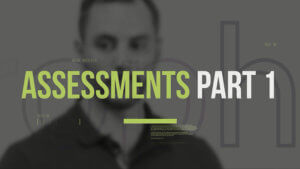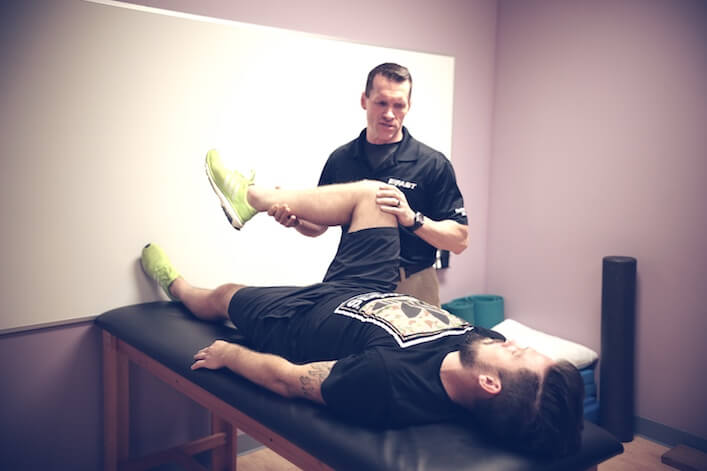Note from MR: Today I’ve got a really interesting guest post from Dean Somerset on the topic of assessments.
Before you read it, make sure to take a deep breath and put your personal preferences aside. Read with an open mind and listen to what he’s saying here.
And if you want to learn more from Dean on the topic of assessments, be sure to check out his L2 Fitness Summit course that he’s launching this week. Not only does it have NSCA CEU’s, but you’ll also save $50 if you pick it up by December 10th at midnight.
Here’s Dean…
Assessments are a pretty hot topic in the fitness industry, specifically because no one can really agree as to what is and isn’t a good assessment tool to use, and because there’s really no scientific consensus on anything, especially if taken across a broad population.
Sure, some screens have been massively popular and recognized far and wide, but it’s hard to tell if they’re accurate to use with populations like geriatrics, youth, or even with different genders.
Even the concept of body composition measurement isn’t very concise, especially since most of the common techniques are based on body values deemed to be constant (like body density, or tissue weight over volume), but that actually fluctuate pretty significantly across different populations, ages, genders, and activity levels.
Some entrenched elements have just been accepted, even though there’s no real reason for them to have been considered anything but a passing thought.
Need An Example? Let’s Talk Max Heart Rate…
Think of this: how do you determine maximum heart rate for an individual?
Well, I’m sure you likely thought about 220 minus the persons age, right?
The funny thing is this formula has zero reason to be in existence.
Part of that comes to how inaccurate it is (it significantly overestimates heart rates in young people and significantly underestimates it in people over 40), but there have never been any studies published that verify it. It just exists and is passed off as carnal law in the fitness industry.
The 220-age formula was first used arbitrarily in a study that looked at a total of 10 studies that measured max heart rate in terms of cardiovascular disease risk, among others, and compared risk factors of active employment versus sedentary employment.
Fox et al (1971) used a line of best fit when looking at max heart rates across different studies, more of a “this seems to work” concept than any hard scientific study, and since it’s been picked up and used in certifications, text books, and published papers without much citation at all.
However, even in the original research by Fox, the formula isn’t mentioned, but the one he did use was HRmax = 215.4-0.9147(age) and showed an r value – 0.51, which means it’s not very accurate, just more of a neat thing to look at.
In fact, since that paper was published in 1971, there’s been more than 30 potential univariate formulaes published to determine max heart rate from your age, all involving that same “number – (decimal point)age” formula, and ranging in r value between 0.00 (yikes) and 0.81 (not bad).
For the research geeks out there, the use of these kinds of formulas doesn’t seem too promising.
What About Commercial Assessments?
Even looking at commercially available movement screens like the FMS, there seems to be no consensus in the research as to whether they work or not for their purported purposes.
This year alone there were 2 metanalyses published to see if the score of 14 or less on the screen increased injury risk. One found there was an increased risk of injury with a score of less than 14, and in another study showed than there was evidence in military personnel and soccer with limited or conflicting evidence of an association with runners, American football, police officers, hockey and basketball players.
Essentially, the big questions come down to whether it’s a valuable system to use for different populations, genders, or age groups, and at this point there isn’t enough research to effectively answer that question.
It’s a great tool to get a lot of visual info on how someone moves with simple tasks, and is fantastic if working with larger groups where you may not be able to spend an hour or two analyzing kinematics of each specific joint in your clients or patients.
So in many ways, we have no true idea of what we’re doing when it comes to assessments. Most of the commonly used techniques have minimal direct application, limited use in different populations, and may not be accurate at all.
“So What Should I Be Using?”
The cool thing is there’s a lot of tools out there to use, and it comes down to how the trainer or coach views the tool and the info they get from that tool relative to their specific population.
For instance, if I have a client who has recently had a hip replacement, a treadmill walk test can double as both a cardiovascular assessment and local muscular endurance test for the hip. I can do some manual assessments on ranges of motion through the joint, some strength testing in safe zones, and look at how they do basic supported movements like a squatting into a chair, walking on the treadmill, or bending to touch their shoe without any specific requirements of depth, control, etc.
This kind of assessment would be woefully inadequate for a young athlete looking for some performance outcomes though. Something like a combine used in the NFL would be a better option, but it’s come under fire for not effectively predicting performance on the field.
Again, we’re stuck with ineffective measurements. What should we be doing in our assessments if common tools suck, don’t measure what they’re supposed to measure, and may not apply to the individuals goals or situation?
In any assessment, one of the predominant drivers should be the individual’s goals, whatever that may be.
From there, the assessment should outline where that individual is at this point in time relative to their goal, and what it would take to achieve that goal.
It should also outline the stuff they are capable of doing that would be of use to get that goal, stuff they need to do, develop, or further refine to help achieve their goal, as well as stuff they can’t do that might be useful to their goal or would need to adjust the training program to help them achieve their goal.
You should also get some outline of red flags or safety precautions for the individual to know whether you’re about to injure or seriously harm them versus train them safely and effectively.
This is a purposely broad outline of the goals of the assessment, specifically because of how many different people it could be applied to, whether they’re looking to lose weight, recover from surgery, get jacked and swole, or improve their fastball velocity. Obviously each would have a different need from their assessments and would benefit from different tools, so let’s break down important info in each of those characteristics mentioned above.
Individuals Goals
Each goal will have somewhat different ways of achieving them based on programs that have shown success in the past across large segments of the population.
- Weight loss – caloric expenditure coupled with a nutritional deficit
- Powerlifting – squat, bench and deadlift training with assistance lifts to bring up weak areas and keep healthy while periodizing stress for competition
- Gaining muscle – accumulating stress through loading and volume while in a nutritional surplus
- Sport performance – identify elements of the sport, from metabolic demands to specific movements, and improve performance in individual elements and on-field performance
- Rehab – specific protocols from surgeries, medical professionals, and understanding tissue healing properties
The goal of the assessment should be to find out how close the individual is to achieving that goal, and what has to be done to accommodate getting them into that best program.
For instance, in weight loss, has the individual found success in the past with a specific approach, and are they able to identify triggers or struggles they would have at remaining active and keeping a caloric deficit?
For the powerlifter, can they execute the movements effectively and with the technique required for their federation to judge a good lift?
For something like rehab, there’s a lot of factors involved that go beyond a simple blog post, but much of it will come down to how well can they heal and progressively build up the resilience of the tissue to get back to doing what they want to do again.
If there’s a specific movement they’re required to do, we can test that movement and see whether they can do it well enough to assume they just need more work on practice, or regressions or some retraining of specific aptitudes.
An example of this would be a squatter who may not have the hip mobility to get to depth without rounding their low back. This movement may lead to more stress on the low back than you would want, and likely some reduced performance versus getting to depth with true hip flexion. You could work on improving control of hip flexion in that range, modifying tissue flexibility with static stretching and other mobility tools, pause squats, lifting shoes, wraps and braces, and take the programming from there.
If a bodybuilder wants to work on their shoulders but they can’t get their arms over their head, you might have to avoid overhead pressing but could include some landmine variations, incline presses, or other things that would be beneficial for shoulder size and not compromise their shoulder health by forcing a range of motion that doesn’t exist.
If the individual has some limited mobility, they would benefit from more time to improve that quality before jumping into strength work, but if they’re someone who is rather hypermobile, they would benefit more from active control drills like bracing, loaded carries, and anything that teaches control through their available range of motion.
Older people would benefit from more time working on warm ups and mobility control versus younger people, and younger people would benefit from a lot of time spent on the basics with progressive loading within their ability.
Summary
To summarize, here’s what you need to do:
Identify their goals, test their abilities to see what they can do today, outline a plan to move forward towards their goals, and reassess to determine progress.
The exact specifics of each situation will change from one person to the next, but keeping a relative outline fairly open ended helps to allow for flexibility in choosing what to look at and also what may be valuable to the client.
I’m not too worried about increasing big toe dorsiflexion in a weight loss client, but it may be massively important for a distance runner with a history of plantar fasciitis, so that variability can be the best takeaway from todays’ post.
 When in doubt, do what matters most for the client.
When in doubt, do what matters most for the client.
Want to learn more from Dean? Check out his new product (The L2 Fitness Summit) with Mike Isratael. In this 11-hour video series, Dean gives you the ins-and-outs of his assessment process, while Mike gives you some hardcore information on building muscle the right way.
If you’re interested, you can pick up a copy of the L2 Fitness Summit for only $97 this week only.

